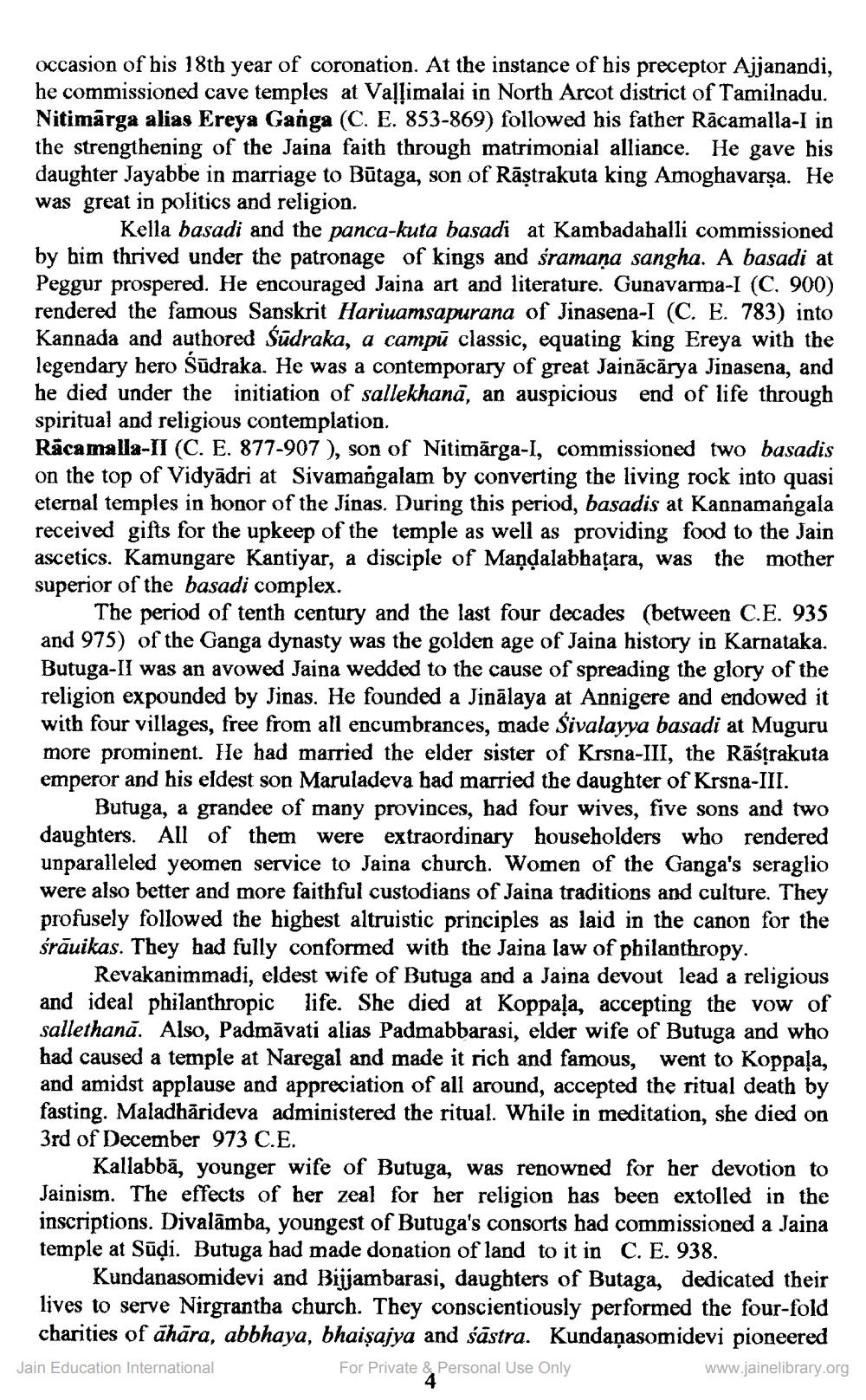Book Title: Jinamanjari 2000 04 No 21 Author(s): Jinamanjari Publisher: Canada Bramhi Jain Society Publication View full book textPage 7
________________ occasion of his 18th year of coronation. At the instance of his preceptor Ajjanandi, he commissioned cave temples at Valțimalai in North Arcot district of Tamilnadu. Nitimārga alias Ereya Ganga (C. E. 853-869) followed his father Rācamalla-I in the strengthening of the Jaina faith through matrimonial alliance. He gave his daughter Jayabbe in marriage to Būtaga, son of Rāştrakuta king Amoghavarşa. He was great in politics and religion. Kella basadi and the panca-kuta basadi at Kambadahalli commissioned by him thrived under the patronage of kings and śramana sangha. A basadi at Peggur prospered. He encouraged Jaina art and literature. Gunavarma-I (C. 900) rendered the famous Sanskrit Hariuamsapurana of Jinasena-I (C. E. 783) into Kannada and authored Sūdraka, a campū classic, equating king Ereya with the legendary hero Sudraka. He was a contemporary of great Jainācārya Jinasena, and he died under the initiation of sallekhana, an auspicious end of life through spiritual and religious contemplation. Rācamalla-II (C. E. 877-907 ), son of Nitimārga-I, commissioned two basadis on the top of Vidyādri at Sivamangalam by converting the living rock into quasi eternal temples in honor of the Jinas. During this period, basadis at Kannamangala received gifts for the upkeep of the temple as well as providing food to the Jain ascetics. Kamungare Kantiyar, a disciple of Mandalabhatara, was the mother superior of the basadi complex. The period of tenth century and the last four decades (between C.E. 935 and 975) of the Ganga dynasty was the golden age of Jaina history in Karnataka. Butuga-II was an avowed Jaina wedded to the cause of spreading the glory of the religion expounded by Jinas. He founded a Jinālaya at Annigere and endowed it with four villages, free from all encumbrances, made Šivalayya basadi at Muguru more prominent. He had married the elder sister of Krsna-III, the Rāśtrakuta emperor and his eldest son Maruladeva had married the daughter of Krsna-III. Butuga, a grandee of many provinces, had four wives, five sons and two daughters. All of them were extraordinary householders who rendered unparalleled yeomen service to Jaina church. Women of the Ganga's seraglio were also better and more faithful custodians of Jaina traditions and culture. They profusely followed the highest altruistic principles as laid in the canon for the śrāuikas. They had fully conformed with the Jaina law of philanthropy. Revakanimmadi, eldest wife of Butuga and a Jaina devout lead a religious and ideal philanthropic life. She died at Koppaļa, accepting the vow of sallethanā. Also, Padmāvati alias Padmabbarasi, elder wife of Butuga and who had caused a temple at Naregal and made it rich and famous, went to Koppaļa, and amidst applause and appreciation of all around, accepted the ritual death by fasting. Maladhārideva administered the ritual. While in meditation, she died on 3rd of December 973 C.E. Kallabbā, younger wife of Butuga, was renowned for her devotion to Jainism. The effects of her zeal for her religion has been extolled in the inscriptions. Divalāmba, youngest of Butuga's consorts had commissioned a Jaina temple at Sūdi. Butuga had made donation of land to it in C. E. 938. Kundanasomidevi and Bijjambarasi, daughters of Butaga, dedicated their lives to serve Nirgrantha church. They conscientiously performed the four-fold charities of ahāra, abbhaya, bhaișajya and śāstra. Kundaņasomidevi pioneered Jain Education International For Private Personal Use Only www.jainelibrary.orgPage Navigation
1 ... 5 6 7 8 9 10 11 12 13 14 15 16 17 18 19 20 21 22 23 24 25 26 27 28 29 30 31 32 33 34 35 36 37 38 39 40 41 42 43 44 45 46 47 48 49 50 51 52 53 54 55 56 57 58 59 60 61 62 63 64 65 66 67 68 69 70 71 72 ... 88
